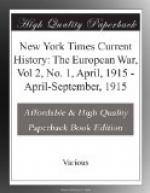Late in the afternoon of the 3d there was sniping from the east bank between Tussum and Serapeum and a man was killed in the tops of a British battleship. Next morning the sniping was renewed, and the Indian troops, moving out to search the ground, found several hundred of the enemy in the hollow previously mentioned. During the fighting some of the enemy, either by accident or design, held up their hands, while others fired on the Punjabis, who were advancing to take the surrender, and killed a British officer. A sharp fight with the cold steel followed, and a British officer killed a Turkish officer with a sword thrust in single combat. The body of a German officer with a white flag was afterward found here, but there is no proof that the white flag was used. Finally all the enemy were killed, captured, or put to flight.
With this the fighting ended, and the subsequent operations were confined to “rounding up” prisoners and to the capture of a considerable amount of military material left behind. The Turks who departed with their guns and baggage during the night of the 3d still seemed to be moving eastward.
So ended the battle of the Suez Canal. Our losses have been amazingly small, totaling about 111 killed and wounded.
[Illustration: Showing the Turkish points of concentration in Palestine and the principal routes leading thence to the Suez Canal. The intervening desert Peninsula of Sinai constitutes a formidable obstacle to an invading force. Inset is a map of the Ottoman Empire showing in the northeast the Caucasus, where the Turks were routed by the Russians, who later advanced on Erzerum and Tabriz. The British expedition in the Persian Gulf region occupied Basra and was on Feb. 1, 1915, at Kurna, the point of confluence of the Tigris and Euphrates.]
Our opponents have probably lost nearly 3,000 men. The Indian troops bore the brunt of the fighting and were well supported by the British and French warships and by the Egyptian troops. The Turks fought bravely and their artillery shot well if unluckily, but the intentions of the higher command are still a puzzle to British officers.
Did Djemal Pasha intend to try to break through our position under cover of demonstrations along a front over ninety miles in length with a total force, perhaps, of 25,000 men, or was he attempting a reconnoissance in force? If the former is the case, he must have had a low idea of British leadership or an amazing belief in the readiness and ability of sympathizers in Egypt to support the Turk. Certainly he was misinformed as to our positions, and on the 4th we buried on the eastern bank the bodies of two men, apparently Syrians or Egyptians, who were found with their hands tied and their eyes bandaged. Probably they were guides who had been summarily killed, having unwittingly led the enemy astray. If, on the other hand, Djemal Pasha was attempting a reconnoissance, it was a costly business and gave General Wilson a very handsome victory.




